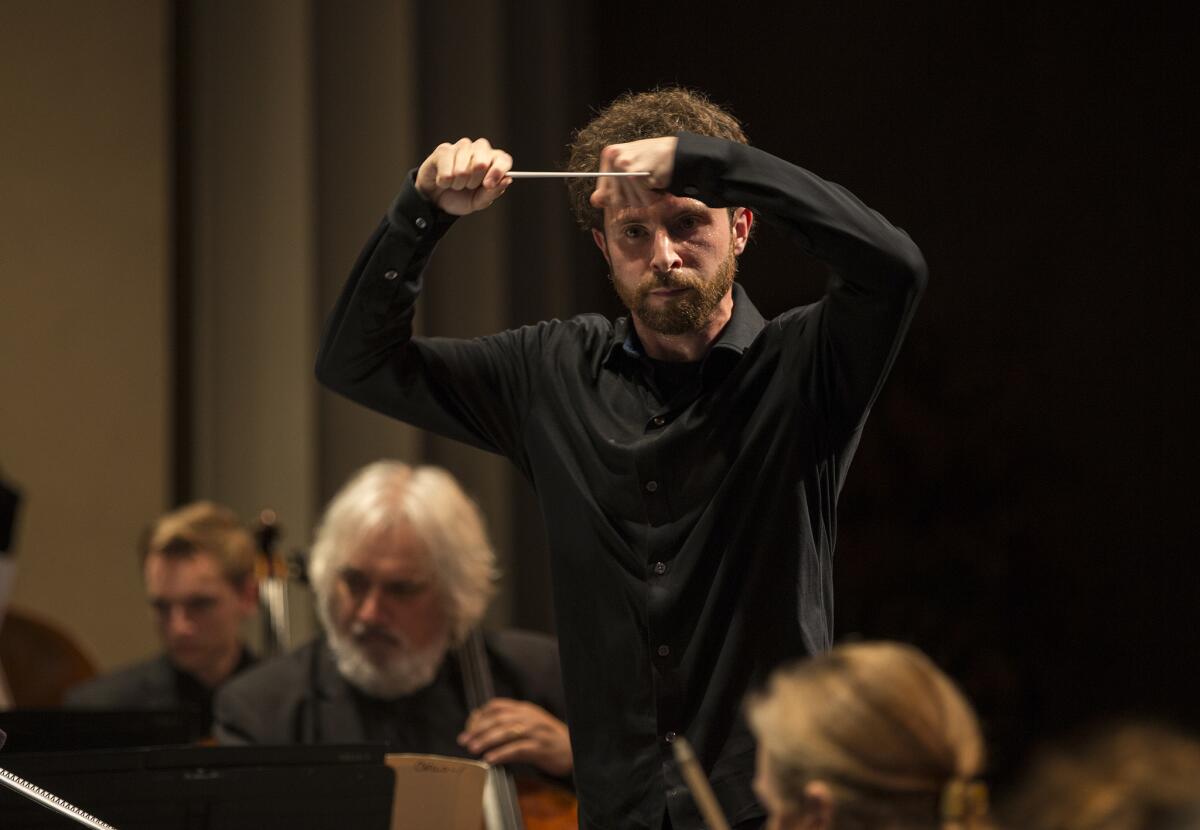Review: Matthew Aucoin’s ‘Evidence’ is evidence of a young composer on the rise

Centering, in the potter’s art, is the act that begins all others, the poet, pedagogue and potter M.C. Richards writes as the act to begin her seminal “Centering.” She ends the book with a poem, the last stanza of which begins, “In the big face of flesh, sits, a sleeping Buddha.”
In between, you might say, is life. We have been reminded of Richards in “Leap Before You Look,” the important Hammer Museum show about the influential, experimental Black Mountain College in North Carolina. That show closed over the weekend, and the Los Angeles Chamber Orchestra played the last subscription program of its season over the weekend.
The concert Saturday night at the Alex Theatre in Glendale was meaningful but without apparent center. So it seems appropriate to turn for guidance to Richards, a pivotal figure at Black Mountain and a free spirit who was the first to leap before looking -- but not before becoming profoundly centered.
LACO’s program began with the latest premiere in the orchestra’s admirable Sound Investment. For the last 15 years, each season has ended with a commission paid for by contributions from the audience. Saturday, it was “Evidence,” a 19-minute score by Matthew Aucoin, a young composer on the rise.
Pianist Marc-André Hamelin made his LACO debut not with something to show off his incomparable virtuosity but with Mozart’s understated Piano Concerto No. 17. Music director Jeffrey Kahane finished the evening with a performance of Schumann’s Symphony No. 2 that had a feverish urgency. But at its center, as at the center of the other pieces and even at the center of the fleshy face of the orchestra itself, sat our mysterious smiling Buddha.
For Aucoin, that Buddha has barely begun to peek out. The 26-year-old American composer and conductor premiered two operas last year that received national attention – “The Crossing” in Boston and “Second Nature” in Chicago. He is serving as a Dudamel fellow with the Los Angeles Philharmonic, and becomes Los Angeles Opera’s first artist in residence in the fall. He has commissions from both the Metropolitan Opera and L.A. Opera.
But until Saturday, Aucoin had no real L.A. presence. That is instantly changing. He conducts the cello extravaganza presented by the L.A. Phil at Walt Disney Concert Hall on Tuesday. His songs will be represented next month in SongFest at the Colburn School. This summer at Music Academy of the West in Santa Barbara, he will conduct his “Second Nature” and Smetana’s “The Bartered Bride.” In the fall, he conducts Philip Glass’ “Akhnaten” for L.A. Opera.
The central idea of “Evidence,” Aucoin said in remarks to the audience Saturday, is the sense that music, while a devotional practice, requires something more specific than belief, namely physical evidence. He then described the process of his score as a kind of journey at sea. An unmoored boat losing power and direction can lead us to uncertain realms from which we rush in panic to solid ground.
The center of the score, he said, made him apprehensive, fearing that boredom would set in with its meditative string drones barely broken by lyrical lines in the winds. Not to worry, boredom is where the Buddha sits.
The first part of “Evidence” is all musical adventure. There are constantly changing figures, some chugging in a John Adams manner. A narrative of going somewhere can be sensed, and the excitement that goes along with such nautical adventure, almost as if this were the accompaniment of a silent film.
In the closing section, escape from aimless drifting becomes imperative. But just about to anchor, the ship runs aground. Strings are now scraped like chalk on a blackboard. There is a tense pause before a couple of quiet plucks in cellos and basses and then a shimmering glassy chord at the end. The Buddha’s been smiling all along.
Aucoin conducted with a show of intent certainty, looking before leaping and not quite ready himself to give in to essential boredom. But the color and character of “Evidence” give evidence of a remarkable composer just setting out and well worth following.
Evidence was needed that Hamelin actually played Mozart’s concerto. His fingers flew across the keyboard, barely looking to touch the keys. He showed no sign of effort. The impression was that of a magic act, and one in which with an imperceptible flick of a finger, he could turn tautness into tenderness.
Hamelin cuts an elegant figure at the keyboard, but he is every inch the smiling Buddha. For a solo encore, he made Earl Wilde’s flamboyant arrangement of Gershwin’s “Lisa” seem the last word in exquisitely graceful jazz.
Kahane was in an exuberant mood leading both concerto and Schumann’s Second Symphony. Brilliantly played, the symphony was often very fast and even daringly profligate. It worked sensationally well, however, because by creating a rapt lyricism in slow movement, Kahane showed this to be a symphonic sun around which the other movements orbit.
There was another poignant center Saturday when Kahane paid tribute to retiring oboist Allan Vogel and flutist David Shostac. They have a combined 85 years playing in the orchestra. Shostac spoke of the orchestra’s good karma. Vogel smiled, not as the Buddha but simply out of joy and good humor. They have centered the orchestra for as long as most of us can remember.
More to Read
The biggest entertainment stories
Get our big stories about Hollywood, film, television, music, arts, culture and more right in your inbox as soon as they publish.
You may occasionally receive promotional content from the Los Angeles Times.











